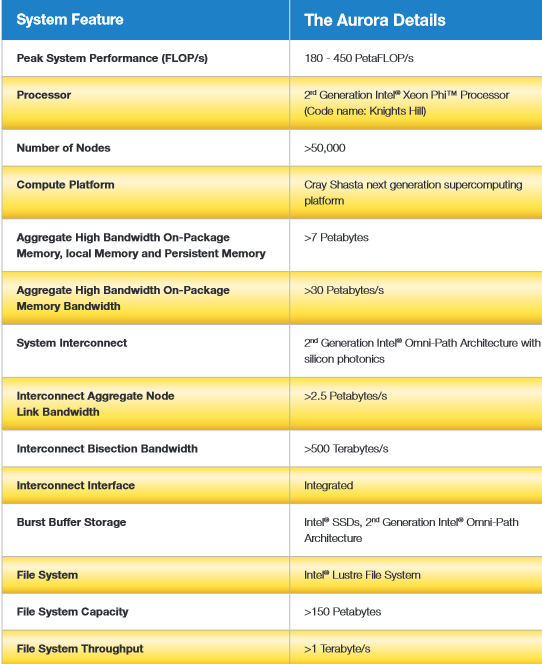Intel will build supercomputers for the US Department of Energy
Argonne Leadership Computing Facility (ALCF), the US Department of Energy’s Computing Center, has selected Intel as its mainframe supplier.
Intel Federal (a subsidiary of Intel) entered into an agreement with ALCF for the supply of two supercomputers for the national laboratory. According to The Wall Street Journal , the cost of the project is estimated at $ 200 million, in addition, for the first time in more than 20 years, such a contract was received by the processor manufacturer, not the system integrator.
The supercomputer will use Intel's scalable high-performance computing environment, which combines next-generation Intel Xeon and Xeon Phi processors, innovative memory technologies, Intel Omni-Path Fabric and Intel Silicon Photonics technologies, the Intel Luster file system, and the ability to integrate these components efficiently. In addition, it provides a single model based on industry standards, which allows you to save investment in existing software code.
The manufacturer of supercomputers, code-named Aurora, will be Cray. The machines will be a continuation of its Shasta line of supercomputers, developed jointly with Intel. Three years ago, Intel acquired part of the integrator’s business for $ 140 million.

This computer is the third and final element of the initiative of three national laboratories: Argonne, Oak Ridge and Lawrence Livermore. The entire project, declared in 2014, is estimated at $ 525 million.

Aurora will be used mainly in the field of nuclear safety, as well as to create more powerful, efficient and durable batteries and other innovative projects in the energy sector, which is not surprising, given the interests of the customer.
The machines will use a new generation of chips, codenamed Knights Hill. According to unconfirmed reports, the chip will have from 90 to 100 Silvermont-type cores at 1.2-1.3 GHz, with added AVX modules, and will be implemented in a 10 nm process.
Intel Federal (a subsidiary of Intel) entered into an agreement with ALCF for the supply of two supercomputers for the national laboratory. According to The Wall Street Journal , the cost of the project is estimated at $ 200 million, in addition, for the first time in more than 20 years, such a contract was received by the processor manufacturer, not the system integrator.
The supercomputer will use Intel's scalable high-performance computing environment, which combines next-generation Intel Xeon and Xeon Phi processors, innovative memory technologies, Intel Omni-Path Fabric and Intel Silicon Photonics technologies, the Intel Luster file system, and the ability to integrate these components efficiently. In addition, it provides a single model based on industry standards, which allows you to save investment in existing software code.
The manufacturer of supercomputers, code-named Aurora, will be Cray. The machines will be a continuation of its Shasta line of supercomputers, developed jointly with Intel. Three years ago, Intel acquired part of the integrator’s business for $ 140 million.
Aurora technical data

This computer is the third and final element of the initiative of three national laboratories: Argonne, Oak Ridge and Lawrence Livermore. The entire project, declared in 2014, is estimated at $ 525 million.
Comparative characteristics

Aurora will be used mainly in the field of nuclear safety, as well as to create more powerful, efficient and durable batteries and other innovative projects in the energy sector, which is not surprising, given the interests of the customer.
The machines will use a new generation of chips, codenamed Knights Hill. According to unconfirmed reports, the chip will have from 90 to 100 Silvermont-type cores at 1.2-1.3 GHz, with added AVX modules, and will be implemented in a 10 nm process.
